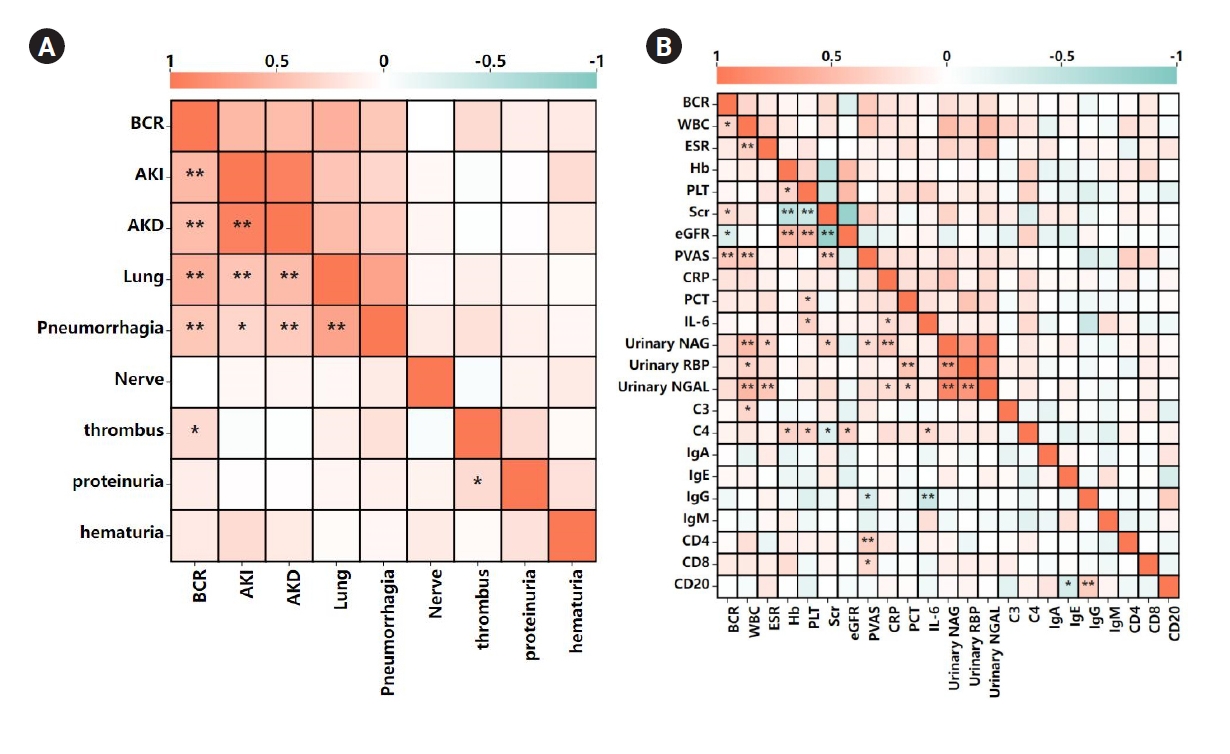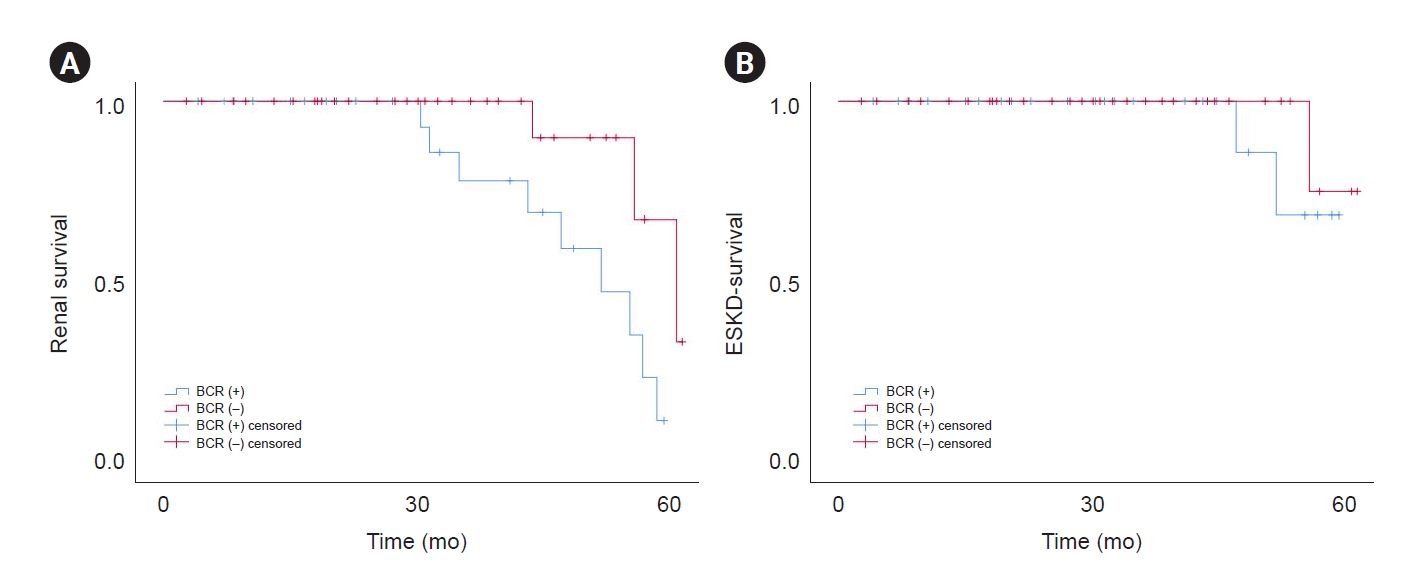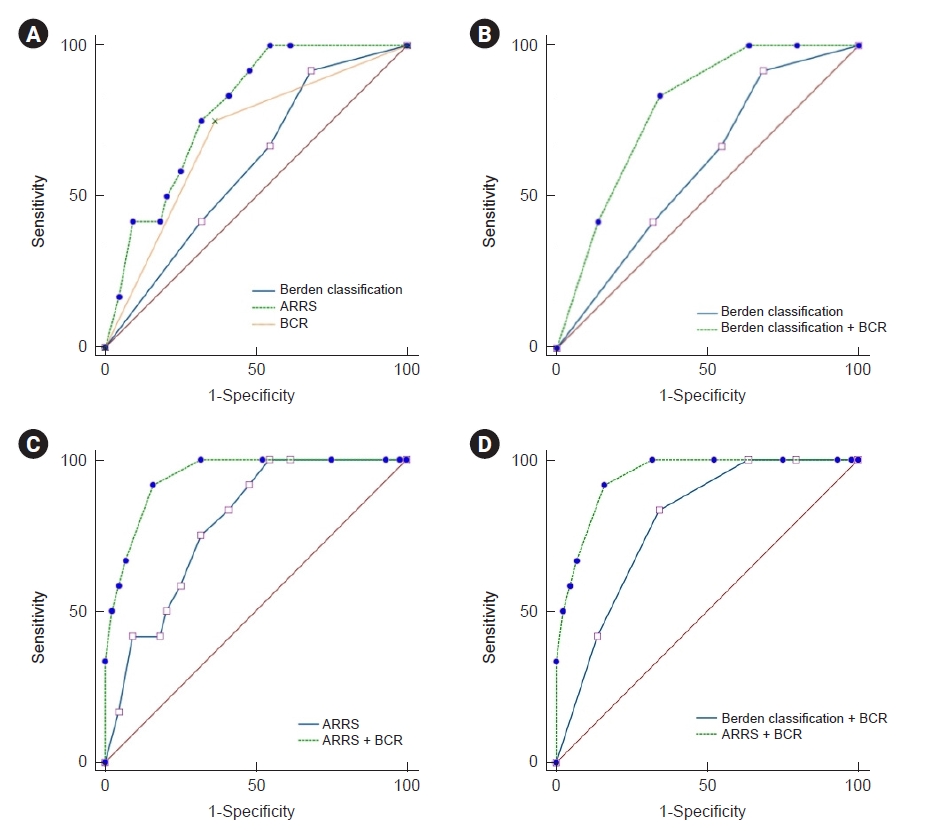1. Nakazawa D, Masuda S, Tomaru U, Ishizu A. Pathogenesis and therapeutic interventions for ANCA-associated vasculitis. Nat Rev Rheumatol 2019;15:91ŌĆō101.
2. Morel-Maroger Striker L, Killen PD, Chi E, Striker GE. The composition of glomerulosclerosis. I. Studies in focal sclerosis, crescentic glomerulonephritis, and membranoproliferative glomerulonephritis.
Lab Invest 1984;51:181ŌĆō192.



3. Al-Hussain T, Asiri S, Amer S, Al Mana H, Akhtar M. Patterns of glomerulonephritis with crescents: experience at a tertiary medical center in Saudi Arabia.
Saudi J Kidney Dis Transpl 2017;28:532ŌĆō537.

4. Berden AE, Ferrario F, Hagen EC, et al. Histopathologic classification of ANCA-associated glomerulonephritis.
J Am Soc Nephrol 2010;21:1628ŌĆō1636.


5. Brix SR, Noriega M, Tennstedt P, et al. Development and validation of a renal risk score in ANCA-associated glomerulonephritis.
Kidney Int 2018;94:1177ŌĆō1188.


6. Koyama A, Yamagata K, Makino H, et al. A nationwide survey of rapidly progressive glomerulonephritis in Japan: etiology, prognosis and treatment diversity.
Clin Exp Nephrol 2009;13:633ŌĆō650.


7. Sethi S, DŌĆÖAgati VD, Nast CC, et al. A proposal for standardized grading of chronic changes in native kidney biopsy specimens.
Kidney Int 2017;91:787ŌĆō789.



8. Roufosse C, Simmonds N, Clahsen-van Groningen M, et al. A 2018 reference guide to the Banff Classification of Renal Allograft Pathology.
Transplantation 2018;102:1795ŌĆō1814.


9. LŌĆÖImperio V, Vischini G, Pagni F, Ferraro PM. BowmanŌĆÖs capsule rupture on renal biopsy improves the outcome prediction of ANCA-associated glomerulonephritis classifications.
Ann Rheum Dis 2022;81:e95.



10. An XN, Wei ZN, Yao XY, et al. Evaluating renal outcome of ANCA-associated renal vasculitis: comparative study of two histopathological scoring systems.
Clin Exp Rheumatol 2021;39 Suppl 129:39ŌĆō45.


11. Saito M, Saito A, Abe F, et al. Evaluation of a newly proposed renal risk score for Japanese patients with ANCA-associated glomerulonephritis.
Clin Exp Nephrol 2022;26:760ŌĆō769.


12. Hong Y, Shi P, Liu X, et al. Distinction between MPO-ANCA and PR3-ANCA-associated glomerulonephritis in Chinese patients: a retrospective single-center study.
Clin Rheumatol 2019;38:1665ŌĆō1673.



13. Calatroni M, Consonni F, Allinovi M, et al. Prognostic factors and long-term outcome with ANCA-associated kidney vasculitis in childhood.
Clin J Am Soc Nephrol 2021;16:1043ŌĆō1051.



14. Dolezalova P, Price-Kuehne FE, Ûzen S, et al. Disease activity assessment in childhood vasculitis: development and preliminary validation of the Paediatric Vasculitis Activity Score (PVAS).
Ann Rheum Dis 2013;72:1628ŌĆō1633.



15. Levey AS. Defining AKD: the spectrum of AKI, AKD, and CKD.
Nephron 2022;146:302ŌĆō305.


16. Hakroush S, Tampe D, Str├Čbel P, Korsten P, Tampe B. Comparative histological subtyping of immune cell infiltrates in MPO-ANCA and PR3-ANCA glomerulonephritis.
Front Immunol 2021;12:737708.



17. Pieters TT, Falke LL, Nguyen TQ, et al. Histological characteristics of acute tubular injury during delayed graft function predict renal function after renal transplantation.
Physiol Rep 2019;7:e14000.



19. Nakakita T, Akiyama K, Karasawa K, et al. Analysis of various types of glomerulonephritis with crescents at a single center.
Int J Nephrol 2022;2022:1749548.



21. Hakroush S, Tampe B. Correspondence on ŌĆśBowmanŌĆÖs capsule rupture on renal biopsy improves the outcome prediction of ANCA-associated glomerulonephritis classificationsŌĆÖ.
Ann Rheum Dis 2023;82:e125.


22. Lin W, Shen C, Zhong Y, et al. Glomerular immune deposition in MPO-ANCA associated glomerulonephritis is associated with poor renal survival.
Front Immunol 2021;12:625672.



23. Hu X, Shen C, Meng T, et al. Clinical features and prognosis of MPO-ANCA and anti-GBM double-seropositive patients.
Front Immunol 2022;13:991469.



24. Gupta A, Agrawal V, Kaul A, et al. Etiological spectrum and clinical features in 215 patients of crescentic glomerulonephritis: is it different in India?
Indian J Nephrol 2021;31:157ŌĆō162.



25. Gupta R, Singh L, Sharma A, Bagga A, Agarwal SK, Dinda AK. Crescentic glomerulonephritis: a clinical and histomorphological analysis of 46 cases.
Indian J Pathol Microbiol 2011;54:497ŌĆō500.


26. Baier E, Kluge IA, Hakroush S, Tampe D, Tampe B. Leukocyturia and hematuria enable non-invasive differentiation of BowmanŌĆÖs capsule rupture severity in PR3-ANCA glomerulonephritis.
J Nephrol 2023;36:799ŌĆō808.



27. Linke A, Tiegs G, Neumann K. Pathogenic T-cell responses in immune-mediated glomerulonephritis.
Cells 2022;11:1625.



28. Chen A, Lee K, DŌĆÖAgati VD, et al. BowmanŌĆÖs capsule provides a protective niche for podocytes from cytotoxic CD8+ T cells.
J Clin Invest 2018;128:3413ŌĆō3424.



29. Duan T, Zhu X, Zhao Q, et al. Association of BowmanŌĆÖs capsule rupture with prognosis in patients with lupus nephritis.
J Nephrol 2022;35:1193ŌĆō1204.



30. Hakroush S, Tampe D, Korsten P, Str├Čbel P, Tampe B. BowmanŌĆÖs capsule rupture links glomerular damage to tubulointerstitial inflammation in ANCA-associated glomerulonephritis.
Clin Exp Rheumatol 2021;39 Suppl 129:27ŌĆō31.


31. Hakroush S, Tampe B. Neutrophils associate with BowmanŌĆÖs capsule rupture specifically in PR3-ANCA glomerulonephritis.
J Nephrol 2022;35:1177ŌĆō1183.



32. LŌĆÖImperio V, Pagni F. Unveiling the role of additional histological parameters in ANCA-associated vasculitis.
J Am Soc Nephrol 2022;33:1226ŌĆō1227.

















 PDF Links
PDF Links PubReader
PubReader ePub Link
ePub Link Full text via DOI
Full text via DOI Download Citation
Download Citation Supplement figure 1
Supplement figure 1 Print
Print















